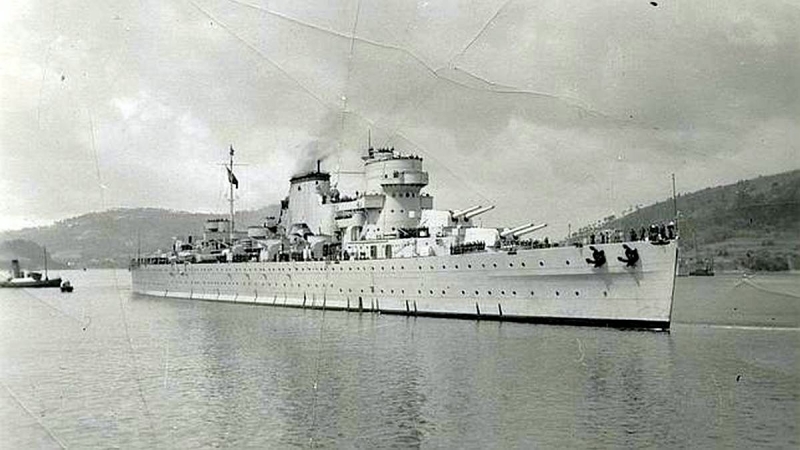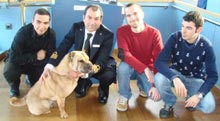| Precedente Successiva |
 |
| Canarias |
| Ships Canarias, Baleares (Nationalist Navy ) Displacement 10,000 tons standard, 13,200 full load Dimensions Length: 193.90 m (636'') Beam: 19.50 m (64') Draft: 6.50 m (21' 4'') Machinery 4 Screws, Parsons Turbines , 8 Yarrow Boilers 90,000 HP.= 33 knots. 8,000 miles/15knots Armament 8x203 mm (8'') /50 cal. -8x120 mm (4.7'') /45 cal. AA;Canarias: -4x40 mm AA -4x20 mm AA;Baleares: -4x100 mm AA -4x20 mm AA Armor V=100-50 mm (4''-2'') H=75-25 mm (3''-1'') Turrets= 25 mm (1'') Bulges Crew 1,200 Laid down: 15 August 1928. Launched: 28 May 1931. Completed: September 1936. Retired : December 1975 The heavy cruisers of the Canarias Class were designed by M.Watts after the British County class, whose general hull lines and main armament can be observed on the Spanish cruisers. The three funnels of the County cruisers were reduced to two and trunked into a single odd-looking uptake. The superstructures was also different, more modern and compact. Horizontal protection was similar to that of their British cousins, but vertical protection was increased. Torpedo bulges were boosted. The machinery was also enhanced in order to reach 33 effective knots. As with the Counties, these cruisers were good seakeepers. The antiaircraft armament consisted in eight 120 mm guns and smaller AA that changed during the war. They were designed to feature 12 fixed torpedo tubes and a catapult but none of these was ever fitted. The Baleares entered service with only three (two according to some other sources) of their 203 mm turrets. They were rushed to commission and would be completed during the war. Their construction began in 1928, political troubles delayed their completion and as of July 1936 they were still fitting at El Ferrol. They therefore fell in the hands of the Nationalists. Their speed and armament were to become among the most valuable Nationalist assets in the conflict. The most famous and active of the ships of the Spanish Civil War entered in service in September 1936, with 102 mm guns instead of the 120 mm AA guns, and a director for land guns. As the ship was quickly commissioned and her crew (for the most part made up of young volunteers) mostly untrained, the Canarias was not used in the Bay of Biscay against the Republican fleet. The Canarias was instead sent with Almirante Cervera to the strait of Gibraltar after the bulk of the Republican fleet headed North. On 29 September, the cruisers spotted two Republican destroyers blocking the strait (Almirante Ferr?ndiz and Gravina). The Canarias opened fire against the Ferr?ndiz at 20000 mt. and scored a fatal hit with the third salvo, sinking the destroyer in a few minutes. The Gravina could manage to escape unscathed to Casablanca. In only a handful of minutes the Nationalists were able to wrest the control of the strait from the Republicans. Moving the Republican fleet to the Bay of Biscay turned out to be a major strategic mistake. In the following months (almost always with the Cervera) she alternated operations in the Bay of Biscay with those in the Mediterranean sea, bombarding the Catalan coast, and supporting the seize of Malaga. In October, the cruisers attempted to intercept the Republican fleet returning to the Mediterranean: the two squadrons crossed their paths at night without founding each other. On 12 December, Canarias sank the Soviet cargo ship Konsomol off Oran. The sinking spurred an international incident, and since then the Soviets would be much less willing to sacrifice their merchant ships to support the Republicans. In February 1937 the Canarias collided with a Greek freighter and she had to be repaired in Cadiz. Baleares then joined her and both cruisers were transferred to their new homeport in Mallorca. In March, she fought in the Bay of Biscay seizing several cargo ships. On April 25, Canarias and Baleares, after bombarding Malaga, entered the harbor of Cartagena and harassed the Republican fleet. After a short skirmish without consequences on either side, the Nationalist cruisers left before enemy shore guns (380 mm-15'') were able to join the fray. They then attempted to intercept the Jaime I which had run aground the previous day but could find shelter in time at Almeria. The Canarias, with the others cruisers, escorted convoys coming from Italy. The night of 23 September, somewhere off Calella (Menorca) the cruiser seized two transports bound for the island, after the three escorting destroyers had fled. In October 1937, after the fall of the northern front, the Nationalist fleet operated in the Mediterranean sea. In January 1938 the Canarias bombarded Barcelona, and in February the Nationalist cruisers bombarded various ports on the Republican controlled coast besides escorting several convoys. On 6 March 1938 the Baleares was sunk while on escort duty. The Canarias, astern in the line formation, took command and proceeded with her escort duty, leaving sailors from the unfortunate ship in the water. They were rescued by British destroyers and when Canarias and Cervera returned after the mission to recover the Nationalist sailors, they were met by a Republican air raid that fortunately didn't score any hit. The Republican Navy wasn't able to take advantage their victory, and cruisers Canarias, Cervera and Navarra, continued with their relentless job of blockading, escorting and bombarding. On 27 August, the Canarias intercepted enemy destroyer Jos? Luis D?ez sorting from Le Havre and bound for Cartagena. The Canarias was able to cripple the destroyer with a single hit but the hapless Jos? Luis D?ez could escape to Gibraltar. Until the end of the war, the only action worth of notice is the blockade of Cartagena in the last days of the war. After the war the Canarias underwent various modifications until she was withdrawn from service in 1975. |
| Username | |
| Armatore | Spanish Navy |
| Ship manager | |
| Numero IMO | |
| Classificazione | Cruiser |
| Cantiere e anno di costruzione | 1936 SECN, El Ferrol |
| Data | |
| Luogo | |
| Aggiunta il | 30/07/2016 |
| Dimensioni | 1200 x 675 |
| visite | 2125 |
















